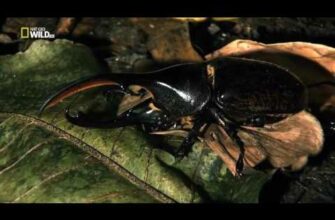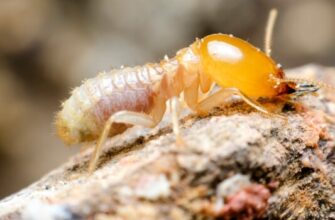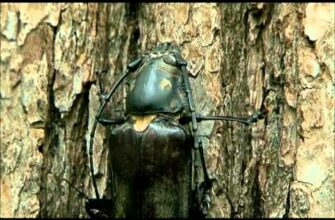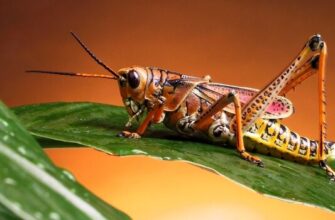The marble bug is a hemiptera belonging to the superfamily Pentatomoidea. With its massive invasion of the southern regions of the country, Holyomorpha halys, a pest with an unpleasant odor, has created many problems.
Origin of the species and description
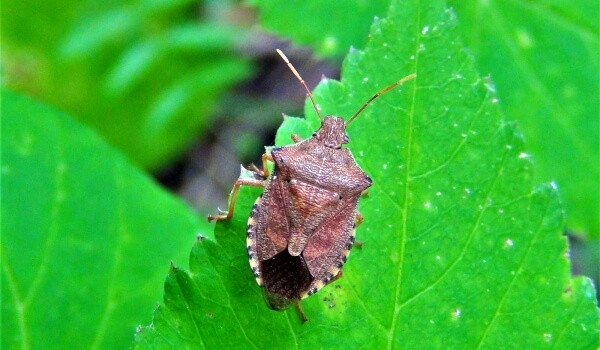
Photo: Marble bug
An insect from the stink bug family in the English-speaking world received a more lengthy name that comprehensively characterizes it: the brown marble stink bug. Like all closest relatives, it belongs to the winged (Pterygota), even more narrowly they are classified as Paraneoptera, that is, to new-winged with incomplete metamorphosis.
Video: Marble bug
The order in which marble bugs are enrolled has the Latin name Hemiptera, which means half-winged, it is also called arthropods. The suborder bugs (Heteroptera) is diverse, has about 40 thousand species, in the territory of the post-Soviet space there are more than 2 thousand species. Next, you should name the superfamily to which the marble bug belongs – these are stink bugs, their back resembles a shield.
An interesting fact: In Latin, stink bugs are Pentatomoidea. Penta — in the name means “five”, and “tomos” – section. This can be attributed to the pentagonal body of the insect, as well as the number of segments on the antennae.
One of the names of the marble, as well as some other similar creatures, is a stink bug. This is due to the ability to emit an unpleasant odor, due to the secret secreted by the ducts of the insect. It is also known as tan and East Asian stink bug,
Appearance and Features
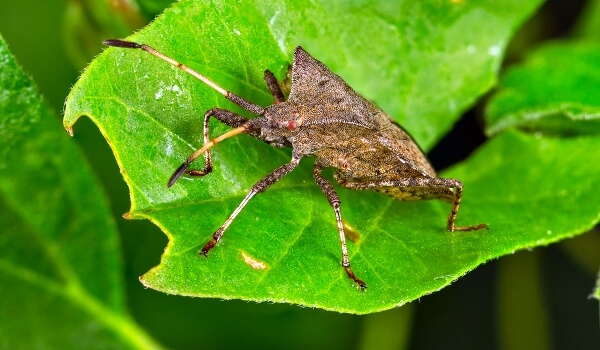
Photo: Marble bug
This bug is relatively large, reaching 17 mm in length, it has the shape of a brown pentagonal shield . Darker color on the back and pale tones on the abdomen. It is all dotted with white, copper, blue dots that make up a marble pattern, for which it got its name.
To distinguish this bug from other fellows, you need to know its characteristic features:
- on the two upper segments of the antennae has alternating light and dark areas;
- on the back of the shield, folded membrane wings are visible as a darker area in the form of a rhombus;
- there is a rim of four dark and five light spots;
- hind legs on the lower leg are light in color;
- there are thickenings in the form of plaques at the top of the shield and back.
Wings of small span are small, folded over a six-segment abdomen. On the prothorax there are exits of ducts of secretory fluid with a very peculiar strong, unpleasant odor, for which cimicic acid is responsible. The head has a pair of compound eyes and a pair of simple eyes.
Where does the marble bug live?
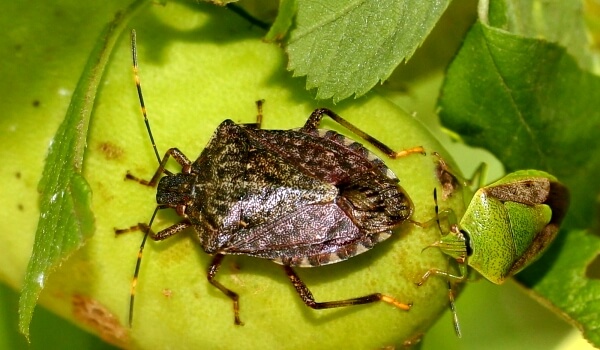
Photo: Marble bug in Abkhazia
In the USA, in the state of Pennsylvania, the pest appeared in 1996, but was officially registered in 2001, after which it settled in New Jersey, Delaware, Maryland, Virginia, West Virginia and Oregon. In 2010, the population of bedbugs in Maryland reached catastrophic proportions, and required special funding for its destruction.
Now it is recorded in 44 states of the USA and in the south of Ontario, Quebec in Canada. It came to European countries around 2000 and spread to almost a dozen countries. Homeland of the Hemiptera — Southeast Asia, it is found in China, Japan, Korea.
The pest came to Russia in 2013 in Sochi, presumably with green spaces. Shchitnik quickly spread along the Black Sea coast, Stavropol, Kuban, Crimea, southern Ukraine, migrated through Abkhazia to Transcaucasia. His appearance was recorded in Kazakhstan and Primorye.
The marble shield bug likes a humid, warm climate and spreads rapidly where winters are mild, where it can survive them. For the cold period, it hides in fallen leaves, in thickets of dry grass. In places unusual for the marble bug, where it is colder in winter than in its homeland, it tends to hide in buildings, sheds, warehouses, residential buildings, sticking to all surfaces.
What does the marble bug eat?
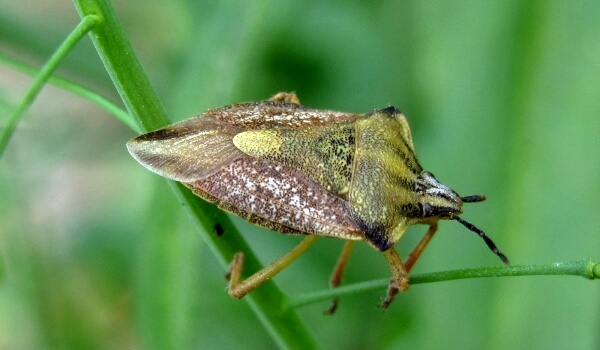
Photo: Marble bug in Sochi
The marble stink bug is a polyphagous insect and feeds on a wide variety of plants; it has about 300 species on its menu. In Japan, it affects cedars, cypresses, fruit trees, vegetables and legumes, such as soybeans. In Southern China, it can be found on forest trees, flowers, stems, pods of various legumes and ornamental crops.
It damages apples, cherries, citrus fruits, peaches, pears, persimmons and other juicy fruits, also mulberries and raspberries. They eat leaves of maple, ailanthus, birch, hornbeam, dogwood, narrow-leaved sucker, forsythia, wild rose, rose, Japanese larch, magnolia, barberry, honeysuckle, chokeberry, white locust, willow, spirea, linden, ginkgo and other trees and shrubs
Most vegetables and grains, such as horseradish, chard, mustard, pepper, cucumber, pumpkin, rice, beans, corn, tomatoes, etc. The pest leaves necrotic spots on young foliage. Bite spots on fruits and vegetables can cause secondary infection, causing the fruits to become mottled with scars, unripe fruits fall off.
Interesting fact: In the United States in 2010, losses caused by marbling amounted to more than $ 20 billion .
In Hemiptera, the oral apparatus is arranged according to the piercing-sucking principle. In front of the head there is a proboscis, which in a calm state is pressed under the chest. Part of the proboscis is the lower lip. It is a groove. It contains jaws made of bristles. The proboscis is covered from above by another lip, which protects the lower one. The lips are not involved in the process of feeding.
The bug pierces the surface of the plant with its upper jaws, which are located on top of the thinner, lower ones, the lower ones close and form two tubules. Saliva flows down the thin, lower channel, and along the upper — plant sap is sucked in.
Interesting fact: European wine producers are seriously concerned about the invasion of the marble shield bug, as it not only damages grapes and vineyards, but can also affect the taste and quality of wine.
Features of character and lifestyle
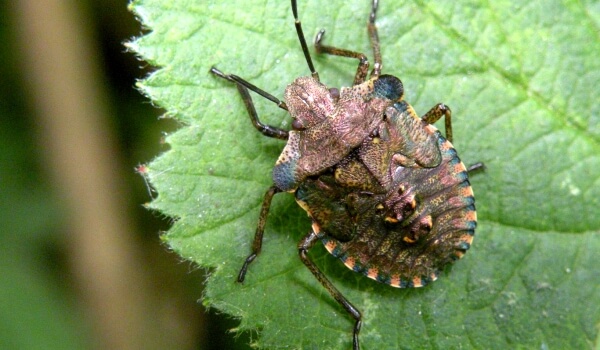
Photo: Marble bug Georgia
This hemipteran is thermophilic, it is:
- active develops at temperatures not lower than +15 °C.;
- feels comfortable at + 20–25 °C.;
- at + 33 °C, 95% of individuals die;
- above + 35 °C — all insect stages are inhibited;
- + 15 °C — embryos can develop, and the larvae that are born die;
- at + 17 ° C, up to 98% of the larvae die.
When the temperature drops, adult insects hide in secluded places. In the conditions of the south of Russia, these are not just natural objects: leaf litter, tree bark or hollows, but also buildings. Insects climb into all the cracks, chimneys, vents. They can accumulate in large quantities in sheds, outbuildings, attics, basements.
The biggest horror for the inhabitants of these regions is that these arthropods massively fill the dwellings. They, having found nooks and crannies, fall into hibernation. In warm rooms, they remain active, fly out into the light, circle around the light bulbs, sit on the windows. In warmer climates, they prefer to hide in the crowns of trees, for example, palovia, ailanthus.
Interesting fact: In the United States, 26 thousand individuals of the marble bug hid for the winter in one house.
Insect is very active, can move long distances. They are versatile in their food preferences.
Social structure and reproduction
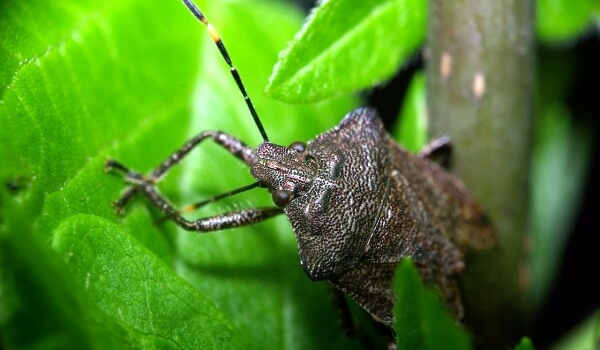
Photo: Marble bug Krasnodar Territory
After the onset of heat, the marble stink bug wakes up, he starts eating to gain strength. After about two weeks, they are ready to mate. In colder regions, only one generation of offspring may appear per season, in more southern regions – two or three. In the homeland of shield insects, for example, in the Chinese subtropical regions, up to six generations during the year.
The female lays 20-40 eggs on the lower part of the leaf of the plant, which will then serve as food for the nymphs. During its life, one individual can produce 400 eggs (average 250). Each light yellow testicle has an elliptical shape (1.6 x 1.3 mm), at the top it is tightly closed with a lid with notches that tenaciously hold it.
At an average temperature of about 20 ° C, a larva emerges from the egg on the 80th day, at a temperature higher than indicated by 10 degrees, this period is reduced to 30 days. There are five nymphal instars (immature stages). They vary in size: from the first age — 2.4 mm to the fifth – 12 mm. The transition from one age to another ends with a molt. Nymphs resemble adult adults, but do not have wings; their rudiments appear in the third stage. They have secretions with smelly liquid, but their ducts are on their backs, and the number of segments on the antennae and legs is less, also there are no simple eyes.
Each age is different in duration:
The first lasts 10 days at 20 C°, 4 days at 30 C°, the color is reddish-orange. At this time, the nymphs are around the eggs.
- The second passes in 16-17 days at 20 C° and 7 days at 30 C°. The nymphs are similar in color to adults.
- The third lasts 11-12 days at 20 C° and 6 days at 30 C°.
- The fourth one ends after 13-14 days at 20 C° and 6 days at 30 C°.
- The fifth one goes on for 20-21 days at 20 C° and 8-9 days at 30 C°.
Marble bugs natural enemies
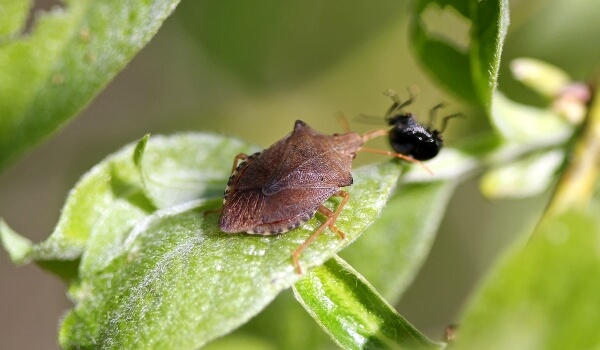
Photo: Marble bug
This stink bug does not have many enemies in nature, not everyone likes this smelly pest.
He is hunted by birds:
- house wrens;
- wrens;
- golden woodpeckers;
- starlings.
They are also eaten with pleasure ordinary domestic chickens. American observers report that in recent years, more birds have been hunting for marbles, and they have begun to peck them more readily.
Interesting fact: Although chickens eat brown pests, farmers complained that poultry meat after that acquire an unpleasant aftertaste.
From insects, stink bugs also have enemies. These include ants, other hemipterans – predators, praying mantises, spiders. There are other stink bugs – podizus, they are predators by nature and can harm the marble. They are outwardly similar in color, but the pods have light paws and there is a dark spot at the end of the calf. Another bug, perillus, also preys on the marbled stink bug, eats eggs and larvae.
In China, the enemy of the marble bug is the parasitic wasp Trissolcus japonicus from the Scelionidae family. They are small, about the size of stink eggs. Wasps lay their eggs in them. The larvae of the winged parasite eat the insides of the egg. They effectively destroy marble bugs, in their geographical range they destroy pests by 50%. In America, the so-called wheel beetle destroys the stink bug, and some species of wood lice eat their eggs.
Population and species status
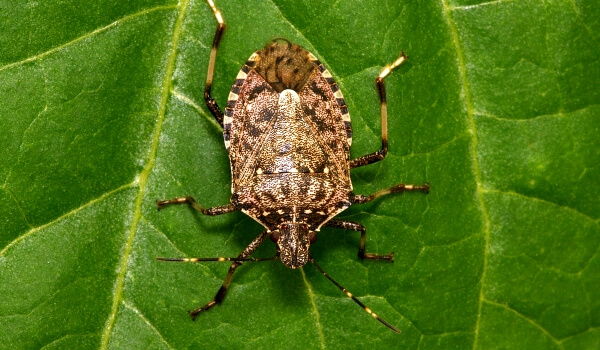
Photo: Marble bug
The number of these insects is growing and difficult to control. Having accidentally found themselves in conditions where they have almost no enemies in nature, the stink bugs began to multiply rapidly. Insects that can effectively regulate their population live in the regions where the marble originally appeared. It quickly adapted to new climatic conditions, and the warming of recent years contributes to survival and an increase in the number of pests.
The best means of struggle may be a frosty winter. But scientists do not rely on nature and try different ways to fight. Along with effective insecticidal preparations that destroy beneficial insects, biological methods are used.
Tests with fungi that infect pests showed that the Boveria species infects up to 80% of bedbugs. The metaricium mushroom proved to be less effective. The difficulty of their use is that high humidity is needed to fight drugs based on mycoses, and the insect chooses dry places for wintering. Traps with pheromones are not always effective: firstly, they do not attract larvae, and secondly, adults also do not always respond to them.
There are high-risk areas where these shield insects can appear and breed:
- South American countries: they can thrive in Brazil, Uruguay, Argentina;
- In the northern regions Africa: Angola, Congo, Zambia;
- New Zealand, southern regions of Australia;
- All of Europe within 30 ° -60 ° latitude;
- In the Russian Federation, it can breed comfortably in the south of the Rostov region, quickly spreading in the Krasnodar and Stavropol regions;
- Where winters are colder, the pest may appear periodically, migrating from the south.
For several years, the marble bug has multiplied so much that it is becoming an ecological disaster. The measures taken are of a deterrent form and cannot drastically affect the increase in the population of this pest. High fertility, flexibility in relation to food and climatic conditions, active migrations, adaptability to chemical preparations — this nullifies all attempts to fight the bug.

